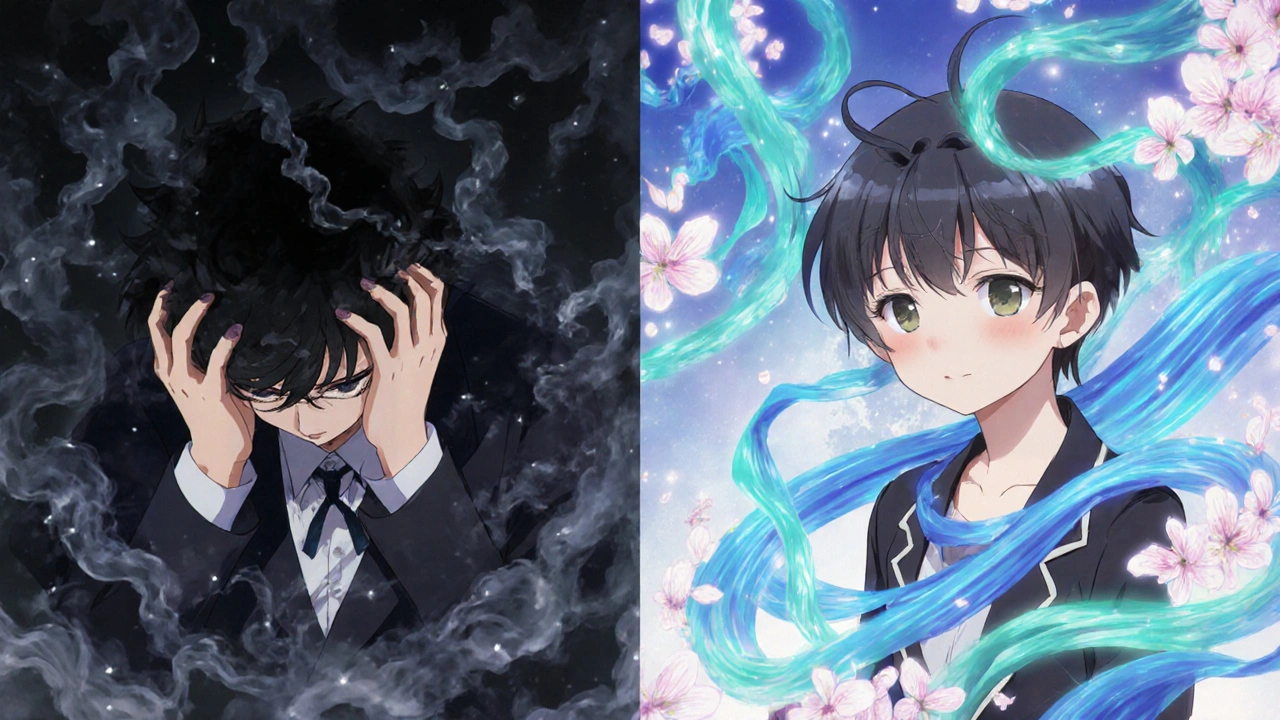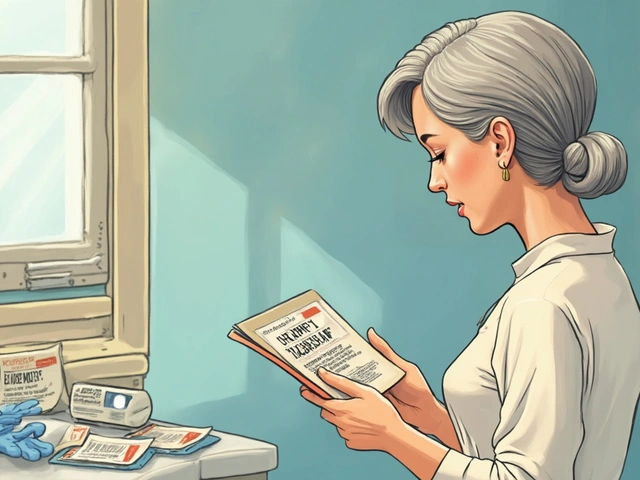Quitting smoking isn’t just about willpower. For many people, the physical addiction to nicotine is what keeps them hooked - not the habit itself. That’s where Zyban comes in. It’s not a nicotine patch or gum. It doesn’t replace the nicotine your body craves. Instead, it works on your brain to reduce the urge to smoke and ease withdrawal symptoms. If you’ve tried quitting before and felt overwhelmed by irritability, anxiety, or intense cravings, Zyban might be the missing piece.
What Is Zyban?
Zyban is the brand name for bupropion hydrochloride. It was originally developed as an antidepressant under the name Wellbutrin. Doctors noticed that patients taking it for depression also reported reduced cravings for cigarettes. That led to clinical trials, and in the 1990s, Zyban became one of the first non-nicotine medications approved specifically to help people quit smoking.
Unlike nicotine replacement therapies (NRTs) like patches or lozenges, Zyban doesn’t deliver any nicotine. Instead, it affects two brain chemicals: dopamine and norepinephrine. These are the same neurotransmitters involved in reward and mood regulation. Smoking boosts them temporarily - which is why quitting feels so rough. Zyban helps stabilize them, so your brain doesn’t scream for a cigarette as loudly.
How Zyban Works to Stop Smoking
When you stop smoking, your brain goes into withdrawal. You might feel restless, anxious, or even depressed. Cravings hit hard - often within minutes of your last cigarette. Zyban doesn’t block nicotine receptors. It doesn’t make you sick if you smoke. It simply makes the withdrawal less severe.
Studies show that people who take Zyban are about twice as likely to quit smoking after six months compared to those who don’t use any medication. One major trial found that 30% of people using Zyban stayed smoke-free after a year, compared to just 15% in the placebo group. That’s a big difference when you’re trying to break a habit that’s been part of your life for years.
You don’t start Zyban on quit day. You begin taking it one to two weeks before you plan to stop. This gives your body time to build up the right level of the drug in your system. Most people take one 150 mg tablet daily for the first three days, then increase to two tablets a day (300 mg total) for the rest of the treatment. The full course usually lasts seven to 12 weeks.
Who Should Use Zyban?
Zyban isn’t for everyone. It’s meant for adults 18 and older who are serious about quitting smoking. If you’ve tried quitting on your own and failed, or if you’ve used nicotine patches or gum without success, Zyban could be worth discussing with your doctor.
It’s especially helpful if:
- You get anxious or irritable when you try to quit
- You smoke more than 10 cigarettes a day
- You’ve tried quitting before and relapsed
- You don’t want to use nicotine products
But there are important restrictions. You should not take Zyban if you:
- Have a seizure disorder or history of seizures
- Have an eating disorder like anorexia or bulimia
- Are taking other medications that contain bupropion (like Wellbutrin)
- Have suddenly stopped drinking alcohol or using sedatives
- Are under 18
Seizures are the most serious risk. The chance is low - about 1 in 1,000 people - but it goes up if you take more than the recommended dose or have other risk factors like head injuries or liver problems.

Side Effects and What to Expect
Most people tolerate Zyban well. But like any medication, it comes with possible side effects. The most common ones include:
- Dry mouth
- Insomnia or trouble sleeping
- Headache
- Nausea
- Dizziness
These usually fade after the first week or two. Taking Zyban in the morning helps reduce sleep problems. If you’re having trouble sleeping, don’t take your second dose after 4 p.m.
Less common but more serious side effects include mood changes, agitation, or thoughts of self-harm. If you feel unusually depressed, anxious, or have new or worsening mental health symptoms while taking Zyban, contact your doctor right away. These reactions are rare but real.
Some people report weight loss while on Zyban. That’s not a side effect to chase - it’s just something that happens sometimes. Don’t use Zyban as a weight-loss drug. It’s not approved for that, and doing so increases your risk of seizures.
Zyban vs. Other Quitting Aids
There are several ways to quit smoking. Here’s how Zyban stacks up against the most common options:
| Method | How It Works | Success Rate (1 Year) | Side Effects | Requires Prescription? |
|---|---|---|---|---|
| Zyban (bupropion) | Stabilizes brain chemicals to reduce cravings | 30% | Dry mouth, insomnia, headache, rare seizures | Yes |
| Nicotine Patch | Delivers slow-release nicotine to reduce withdrawal | 20% | Skin irritation, vivid dreams, dizziness | No |
| Nicotine Gum | Quick nicotine hit to manage cravings | 22% | Jaw pain, upset stomach, hiccups | No |
| Chantix (varenicline) | Blocks nicotine from binding to brain receptors | 35% | Nausea, sleep problems, mood changes | Yes |
| Behavioral Counseling | Teaches coping skills to handle triggers | 25% | None (but requires time and commitment) | No |
Zyban is less effective than Chantix but has fewer gastrointestinal side effects. It’s more effective than nicotine patches or gum alone. Many people combine Zyban with counseling - and that combination boosts success rates even higher.
Real-Life Experience: What People Say
One woman in Halifax, 47, had been smoking for 28 years. She tried patches, cold turkey, even hypnosis. Nothing worked. She started Zyban with a quit date set for two weeks later. She said the first week was rough - she felt like her brain was on edge. But by week three, the cravings dropped off. "I didn’t feel like I was fighting myself anymore," she said. "It was like the noise in my head turned down."
Another man, 52, had a heart attack and was told he needed to quit - immediately. He was terrified. He started Zyban the same day he left the hospital. He didn’t use any nicotine products. After six months, he was smoke-free. "I didn’t need to chew gum or suck on lozenges. I just didn’t want to smoke anymore."
These aren’t rare stories. They’re common enough that Zyban remains one of the most prescribed smoking cessation tools in Canada and the U.S.

How to Get Zyban
You can’t buy Zyban over the counter. You need a prescription from a doctor, nurse practitioner, or other licensed healthcare provider. In Canada, it’s covered by most provincial drug plans, though coverage varies. Some plans require you to have tried other methods first, like nicotine replacement therapy.
Your doctor will ask about your medical history, especially any history of seizures, mental health conditions, or eating disorders. They’ll also check what other medications you’re taking. Zyban can interact with some antidepressants, antipsychotics, and even certain over-the-counter cold medicines.
If you’re in Nova Scotia, you can get Zyban through the provincial drug program. You’ll pay a small co-pay unless you’re on income assistance or over 65. In other provinces, costs range from $30 to $70 for a month’s supply without insurance.
What to Do If Zyban Doesn’t Work
Not everyone quits with Zyban. That doesn’t mean you failed. It just means you need a different approach.
If you’ve taken Zyban for 7 to 12 weeks and still smoke, talk to your doctor. You might try:
- Switching to Chantix
- Combining Zyban with nicotine replacement therapy (patches or gum)
- Adding behavioral counseling or a quit-smoking app
- Trying a different medication or therapy
Some people need more than one try. The average smoker tries to quit five times before succeeding. Each attempt teaches you something. Zyban might be the tool that finally gives you the edge.
Staying Smoke-Free After Zyban
Stopping the medication doesn’t mean you’re done. The real challenge is staying quit. Cravings can return months later - especially during stress, alcohol use, or social situations where you used to smoke.
Here’s what works:
- Avoid triggers: If you used to smoke after coffee, switch to tea.
- Keep busy: When a craving hits, go for a walk, chew gum, or call a friend.
- Use apps: Tools like Smoke Free or QuitNow! send daily encouragement and track progress.
- Find support: Join a local quit-smoking group or online community.
Most people who quit with Zyban and stick with it for six months have a 90% chance of staying quit for good. The key isn’t the drug - it’s the commitment that follows.
Can I drink alcohol while taking Zyban?
It’s best to avoid alcohol while taking Zyban. Alcohol can increase your risk of seizures, especially if you drink heavily or have a history of alcohol use. Even moderate drinking can make side effects like dizziness or insomnia worse. If you’re used to drinking socially, consider cutting back or pausing until you’re fully quit from smoking.
How long does Zyban stay in your system?
Zyban has a long half-life - about 21 hours. That means it takes nearly a full day for half the dose to leave your body. After you stop taking it, most of the drug is gone in about five days. But its effects on brain chemistry can last longer, which is why it’s important to taper off under medical supervision rather than stopping suddenly.
Can I take Zyban if I’m pregnant or breastfeeding?
Zyban is not recommended during pregnancy or breastfeeding. While quitting smoking is extremely important for your baby’s health, the risks of bupropion to a developing fetus aren’t fully known. If you’re pregnant and trying to quit, talk to your doctor about safer options like nicotine patches or counseling. For breastfeeding, bupropion passes into breast milk in small amounts, and its effects on infants aren’t well studied.
Is Zyban addictive?
No, Zyban is not addictive. It doesn’t produce euphoria or a high. You won’t develop a physical dependence on it. That’s why it’s safe to stop after the recommended course. Unlike nicotine, it doesn’t activate the brain’s reward system in a way that leads to craving or withdrawal when you stop.
Can I use Zyban with nicotine patches or gum?
Yes, combining Zyban with nicotine replacement therapy (NRT) is safe and often more effective than using either alone. Studies show that people who use both have a 35-40% success rate at one year. This approach gives you the brain support of Zyban plus the physical craving relief of nicotine. Talk to your doctor about the right combination and dosage - you’ll need to be monitored closely.
If you’re serious about quitting smoking, Zyban gives you a real, science-backed tool to help. It’s not magic. It won’t make you never want a cigarette again. But it can take the edge off the worst of the withdrawal - the part that makes quitting feel impossible. With the right support, the right timing, and the right mindset, it can be the difference between giving up - and finally, truly quitting.








8 Comments
Brandon Lowi
November 20, 2025 AT 02:51Zyban? Man, this is what happens when Big Pharma turns neuroscience into a sales pitch-like your brain’s a broken radio and they’re selling you a $90 tuner that might give you a seizure. I mean, sure, it ‘stabilizes dopamine,’ but what’s next? A pill for not craving pizza? For not yelling at your boss? We’re medicating the human condition now, folks. Wake up. Quit smoking the old-fashioned way: grit, willpower, and a damn good curse word or two.
Alex Boozan
November 21, 2025 AT 13:57From a clinical pharmacology standpoint, bupropion’s mechanism of action as a norepinephrine-dopamine reuptake inhibitor (NDRI) directly modulates the mesolimbic reward pathway, thereby attenuating the neuroadaptations associated with chronic nicotine exposure. The 30% abstinence rate at 12 months is statistically significant (p<0.01) versus placebo in multiple RCTs, including the landmark EAGLES trial. However, the seizure risk, though low, remains a Class I contraindication in patients with prior CNS trauma or metabolic derangements. Always screen for comorbidities.
Evan Brady
November 22, 2025 AT 03:17Just want to add something real: I was a 2-pack-a-day guy for 15 years. Tried patches, cold turkey, even hypnosis (yes, really). Nothing stuck. Then I tried Zyban-started it two weeks before my quit date, took it first thing in the morning, and avoided caffeine after noon. The first week was rough-dry mouth like chewing cotton, insomnia like I’d been up for three days straight. But by day 14? The cravings just… faded. Like someone turned down the volume on a screaming alarm. I didn’t miss smoking. I didn’t crave it. I just didn’t need it. And no, I didn’t lose weight on purpose-just stopped snacking while smoking. If you’ve tried everything else and still feel like your brain’s fighting you, give this a real shot. Not magic. Just science that works.
Ram tech
November 23, 2025 AT 11:14zayban? why not just stop? its just another pill. i smoke 5 cigs a day anyway. why waste money? my cousin tried it and still smoked. lol
Jenny Lee
November 24, 2025 AT 07:56I tried Zyban. It worked. No drama. Just quiet freedom.
Jeff Hakojarvi
November 24, 2025 AT 21:56Hey, just wanted to say-I took Zyban last year after my second heart scare. Was terrified. Didn’t want nicotine gum because I hated the taste. Took it exactly as the doc said: started 2 weeks early, no caffeine after 3 p.m., and kept a journal. The insomnia was rough, but manageable. And honestly? The biggest win wasn’t the cravings fading-it was that I stopped feeling like a failure every time I thought about smoking. I didn’t fight it. It just… stopped mattering. If you’re on the fence, talk to your doc. This isn’t a magic bullet, but it’s one of the few tools that actually respects your brain instead of just replacing one addiction with another.
Timothy Uchechukwu
November 25, 2025 AT 02:51Why do Americans need a pill to quit smoking? In Nigeria we just spit on the ground and walk away. Your whole society is broken if you need chemicals to stop a habit your grandparents did without. Zyban is just another way the West sells weakness as a disease. Smoke if you want. Quit if you can. But don’t call it medicine. Call it capitalism with a prescription.
Ancel Fortuin
November 26, 2025 AT 08:10Let me guess-Zyban was developed by a shadowy pharma consortium to replace nicotine with a more profitable chemical dependency. They didn’t want you to quit. They wanted you to be *dependent on the quit drug*. And now you’re paying $70 a month to feel less like a smoker… while they sell you the next ‘solution’ for your anxiety, your insomnia, your existential dread. Wake up. The real addiction? Believing Big Pharma has your best interests at heart.